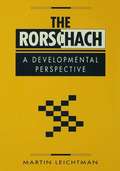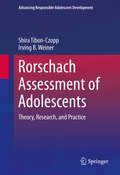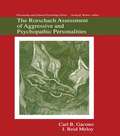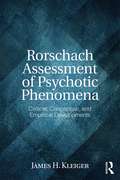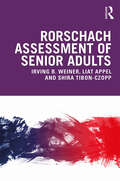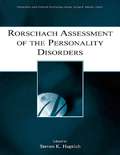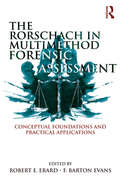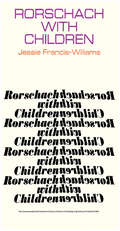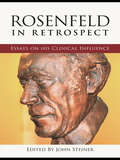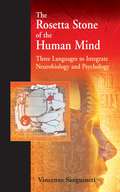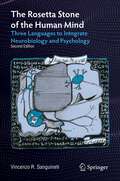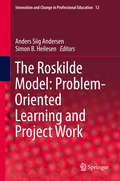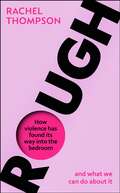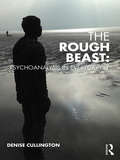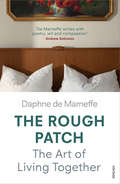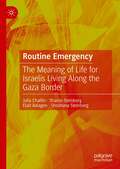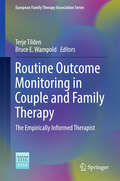- Table View
- List View
The Rorschach: A Developmental Perspective
by Martin LeichtmanMartin Leichtman's The Rorschach is a work of stunning originality that takes as its point of departure a circumstance that has long confounded Rorschach examiners. Attempts to use the Rorschach with young children yield results that are inconsistent if not comical. What, after all, does one make of a protocol when the child treats a card like a frisbee or confidently detects "piadigats" and "red foombas"? A far more consequential problem facing examiners of adults and children alike concerns the very nature of the Rorschach test. Despite voluminous literature establishing the personality correlates of particular Rorschach scores, neither Hermann Rorschach nor his intellectual descendants have provided an adequate explanation of precisely what the subject is being asked to do. Is the Rorschach a test of imagination? Of perception? Of projection? In point of fact, Leichtman argues, the two problems are intimately related. To appreciate the stages through which children gradually master the Rorschach in its standard form is to discover the nature of the test itself. Integrating his developmental analysis with an illuminating discussion of the extensive literature on test administration, scoring, and interpretation, Leichtman arrives at a new understanding of the Rorschach as a test of representation and creativity. This finding, in turn, leads to an intriguing reconceptualization of all projective tests that clarifies their relationships to more objective measures of ability.
The Rorschach: A Developmental Perspective
by Martin LeichtmanMartin Leichtman's The Rorschach is a work of stunning originality that takes as its point of departure a circumstance that has long confounded Rorschach examiners. Attempts to use the Rorschach with young children yield results that are inconsistent if not comical. What, after all, does one make of a protocol when the child treats a card like a frisbee or confidently detects "piadigats" and "red foombas"? A far more consequential problem facing examiners of adults and children alike concerns the very nature of the Rorschach test. Despite voluminous literature establishing the personality correlates of particular Rorschach scores, neither Hermann Rorschach nor his intellectual descendants have provided an adequate explanation of precisely what the subject is being asked to do. Is the Rorschach a test of imagination? Of perception? Of projection? In point of fact, Leichtman argues, the two problems are intimately related. To appreciate the stages through which children gradually master the Rorschach in its standard form is to discover the nature of the test itself. Integrating his developmental analysis with an illuminating discussion of the extensive literature on test administration, scoring, and interpretation, Leichtman arrives at a new understanding of the Rorschach as a test of representation and creativity. This finding, in turn, leads to an intriguing reconceptualization of all projective tests that clarifies their relationships to more objective measures of ability.
Rorschach Assessment of Adolescents: Theory, Research, and Practice (Advancing Responsible Adolescent Development #182)
by Shira Tibon-Czopp Irving B. WeinerThis book serves as an up-to-date Rorschach primer and elaborates on the various applications of Rorschach assessment for adolescents with respect to differential diagnosis, forensic consultation, and therapeutic assessment. It opens with three chapters that provide readers with a basic overview and introduction to the topics integrated throughout the text. The first reviews the development and foundations of the Rorschach Inkblot Method; the second discusses key issues in the assessment of adolescents, with particular attention to differentiating patterns of psychopathology from normal developmental variations; and the third presents general considerations in using performance-based assessment instruments in the assessment of personality functioning in adolescence. Later chapters explore the current status of the Rorschach Inkblot Method with respect to theoretical formulations, research findings, and practice guidelines. The final chapter draws on information in the preceding chapters to present a model for Rorschach assessment of adolescents. This model is designed to facilitate accurate and useful formulations of personality functioning that contribute substantially to advancing responsible adolescent development.
The Rorschach Assessment of Aggressive and Psychopathic Personalities (Personality and Clinical Psychology)
by Carl B. Gacono J. Reid MeloyThis book provides a definitive empirical study of antisocial character pathology and its assessment through the use of the Rorschach. Drawing upon a decade of research with nearly 400 individuals in various hospitals and prisons, the authors paint an extraordinary intrapsychic picture of the personality structure and psychodynamics of these troublesome patients.Serving as both an educational tool and a reference text, this book presents: * Rorschach data on several different antisocial groups -- conduct disordered children and adolescents, antisocial personality disordered adult males with and without schizophrenia, antisocial adult females, and male and female sexual homicide perpetrators; * nomothetic (group) and idiographic (case study) data; * data which have been analyzed and theoretically interpreted using both structural methods and psychoanalytic approaches which represent the cutting edge of Rorschach theory and practice; and* a developmental approach in analyzing Rorschach data gathered from antisocial children, adolescents, and adults -- providing striking similarities. This is the first Rorschach database of this type that has ever been published. As such, it serves as a valuable reference text for Rorschach users -- providing a definitive empirical base, theoretical integration, and a focus on individuals who create severe problems for society.
The Rorschach Assessment of Aggressive and Psychopathic Personalities (Personality and Clinical Psychology)
by Carl B. Gacono J. Reid MeloyThis book provides a definitive empirical study of antisocial character pathology and its assessment through the use of the Rorschach. Drawing upon a decade of research with nearly 400 individuals in various hospitals and prisons, the authors paint an extraordinary intrapsychic picture of the personality structure and psychodynamics of these troublesome patients.Serving as both an educational tool and a reference text, this book presents: * Rorschach data on several different antisocial groups -- conduct disordered children and adolescents, antisocial personality disordered adult males with and without schizophrenia, antisocial adult females, and male and female sexual homicide perpetrators; * nomothetic (group) and idiographic (case study) data; * data which have been analyzed and theoretically interpreted using both structural methods and psychoanalytic approaches which represent the cutting edge of Rorschach theory and practice; and* a developmental approach in analyzing Rorschach data gathered from antisocial children, adolescents, and adults -- providing striking similarities. This is the first Rorschach database of this type that has ever been published. As such, it serves as a valuable reference text for Rorschach users -- providing a definitive empirical base, theoretical integration, and a focus on individuals who create severe problems for society.
Rorschach Assessment of Psychotic Phenomena: Clinical, Conceptual, and Empirical Developments
by James H. KleigerRorschach Assessment of Psychotic Phenomena takes the reader beyond where James H. Kleiger’s original work, Disordered Thinking and the Rorschach, left off. This new book offers readers a number of conceptual bridges between Rorschach characteristics commonly associated with psychotic phenomena and a range of psychological, neurocognitive, and psychoanalytic constructs that help psychologists move beyond static, test-bound interpretations of scores and indices. Beginning with a broad-based understanding of disordered thinking and reality testing, Kleiger provides an updated review of the contributions of past Rorschach luminaries and contemporary figures who have helped make the Rorschach a robust tool for assessing aspects of psychotic-level experience. The contributions of major figures are highlighted and assessed in terms of their empirical, conceptual, and practical implications. In addition to providing a balanced, respectful review of each of these leading figures and the systems they developed, Kleiger offers a new way of organizing and conceptualizing what is currently understood about Rorschach scoring variables pertaining to psychotic phenomena. Kleiger’s aim is to help Rorschach practitioners not only consolidate their grasp of key scoring variables and what each means about an individual’s thought processes and internal experiences, but also expand their clinical understanding of the psychotic phenomena being assessed. He includes a wide range of psychotic phenomena, like negative symptoms, cognitive impairment, magical thinking, and impairment of insight, all of which are subjects of diagnostic interest when using the Rorschach with psychotically prone individuals. The final section on psychopathology looks at how the Rorschach is useful in differential diagnosis of primary psychoses and those conditions that may include secondary psychotic phenomena. In step with contemporary DSM-5 standards, Kleiger organizes his discussion of severe psychopathology in a manner consistent with how psychotic phenomena are currently understood in the clinical and scientific literature. In addition to reviewing key clinical characteristics of these conditions, along with Rorschach contributions to the diagnosis of these disorders, he also focuses his lens on the Rorschach assessment of malingered psychosis and psychotic phenomena in children and adolescents. Written with the same well-researched attention to detail and integrative style as Kleiger's earlier work, Rorschach Assessment of Psychotic Phenomena will prove invaluable to clinical psychologists, psychiatrists, and psychoanalysts interested in understanding and assessing psychosis.
Rorschach Assessment of Psychotic Phenomena: Clinical, Conceptual, and Empirical Developments
by James H. KleigerRorschach Assessment of Psychotic Phenomena takes the reader beyond where James H. Kleiger’s original work, Disordered Thinking and the Rorschach, left off. This new book offers readers a number of conceptual bridges between Rorschach characteristics commonly associated with psychotic phenomena and a range of psychological, neurocognitive, and psychoanalytic constructs that help psychologists move beyond static, test-bound interpretations of scores and indices. Beginning with a broad-based understanding of disordered thinking and reality testing, Kleiger provides an updated review of the contributions of past Rorschach luminaries and contemporary figures who have helped make the Rorschach a robust tool for assessing aspects of psychotic-level experience. The contributions of major figures are highlighted and assessed in terms of their empirical, conceptual, and practical implications. In addition to providing a balanced, respectful review of each of these leading figures and the systems they developed, Kleiger offers a new way of organizing and conceptualizing what is currently understood about Rorschach scoring variables pertaining to psychotic phenomena. Kleiger’s aim is to help Rorschach practitioners not only consolidate their grasp of key scoring variables and what each means about an individual’s thought processes and internal experiences, but also expand their clinical understanding of the psychotic phenomena being assessed. He includes a wide range of psychotic phenomena, like negative symptoms, cognitive impairment, magical thinking, and impairment of insight, all of which are subjects of diagnostic interest when using the Rorschach with psychotically prone individuals. The final section on psychopathology looks at how the Rorschach is useful in differential diagnosis of primary psychoses and those conditions that may include secondary psychotic phenomena. In step with contemporary DSM-5 standards, Kleiger organizes his discussion of severe psychopathology in a manner consistent with how psychotic phenomena are currently understood in the clinical and scientific literature. In addition to reviewing key clinical characteristics of these conditions, along with Rorschach contributions to the diagnosis of these disorders, he also focuses his lens on the Rorschach assessment of malingered psychosis and psychotic phenomena in children and adolescents. Written with the same well-researched attention to detail and integrative style as Kleiger's earlier work, Rorschach Assessment of Psychotic Phenomena will prove invaluable to clinical psychologists, psychiatrists, and psychoanalysts interested in understanding and assessing psychosis.
Rorschach Assessment of Senior Adults (Connections Ser.)
by Irving Weiner Liat Appel Shira Tibon-CzoppThis guide is a much-needed reference for clinicians on how to use the Rorschach Inkblot Test with senior adults, an essential tool for assessing personality functioning to better identify psychological interventions. The book integrates historical developments, current research, conceptual considerations, and therapeutic and diagnostic applications. Chapters review basic guidelines for the understanding and interpretation of Rorschach variables, including protocol validity; interpretation of structural variables, thematic imagery, and cross-cultural normative data; sequence analysis; and more. The authors then provide 10 case illustrations of how the Rorschach indices of cognitive functioning, emotional experience, interpersonal relatedness, and self-perception can facilitate differential diagnosis and treatment planning in clinical work with older people. These case illustrations are rooted in previously non-existent Rorschach reference data based on an international sample of more than 250 senior adults and a second sample of more than 200 patients with Alzheimer’s disease. Clinicians will come away with a solid empirical basis for distinguishing between normal-range personality functioning and manifestations of psychological disorder in the elderly and for providing beneficial interventions to senior adult patients.
Rorschach Assessment of Senior Adults
by Irving Weiner Liat Appel Shira Tibon-CzoppThis guide is a much-needed reference for clinicians on how to use the Rorschach Inkblot Test with senior adults, an essential tool for assessing personality functioning to better identify psychological interventions. The book integrates historical developments, current research, conceptual considerations, and therapeutic and diagnostic applications. Chapters review basic guidelines for the understanding and interpretation of Rorschach variables, including protocol validity; interpretation of structural variables, thematic imagery, and cross-cultural normative data; sequence analysis; and more. The authors then provide 10 case illustrations of how the Rorschach indices of cognitive functioning, emotional experience, interpersonal relatedness, and self-perception can facilitate differential diagnosis and treatment planning in clinical work with older people. These case illustrations are rooted in previously non-existent Rorschach reference data based on an international sample of more than 250 senior adults and a second sample of more than 200 patients with Alzheimer’s disease. Clinicians will come away with a solid empirical basis for distinguishing between normal-range personality functioning and manifestations of psychological disorder in the elderly and for providing beneficial interventions to senior adult patients.
Rorschach Assessment of the Personality Disorders (Personality and Clinical Psychology)
by Steven K. HuprichFor decades, The Rorschach Inkblot Method (RIM)--the most popular of the projective tests--has been routinely employed for personality assessment and treatment planning. But in recent years, it has not been free from controversy. Criticisms of its validity and empirical support are catalyzing new efforts to strengthen its foundations and document its broad utility. Among the most common--yet also most confusing and challenging--categories of clinical disorders is the personality disorders. However, minimal data have been available on the RIM evaluation of most of those found in DSM-IV. This welcomed book constitutes the first research-grounded, comprehensive guide to the use of the RIM in assessing personality disorders. The first section offers a theoretical overview of personality disorders and constructs a framework and compelling rationale for the legitimate role of the RIM in their assessment. The second, third, and fourth sections present Cluster A disorders--paranoid, schizoid, and schizotypal; Cluster B disorders--antisocial and psychopathic, borderline, histrionic, and narcissistic; and Cluster C disorders--avoidant, dependent, and obsessive-compulsive. The fifth section presents passive aggressive and depressive personality disorders, currently being proposed for DSM inclusion. Each chapter in these four sections includes an extensive description of the disorder, a review of empirical studies of the use of the RIM to assess it, an analysis of the Rorschach variables that may characterize patients diagnosed with it, and a depiction of a real case and discussion of the ways in which the RIM contributed to its formulation. The sixth and final section explores the relationship between psychoanalytic theory and the RIM. Rorschach Assessment of the Personality Disorders brings practical help for clinicians and clinicians-in-training, and suggests new paths for researchers seeking to advance our understanding of the complexities of these disorders.
Rorschach Assessment of the Personality Disorders (Personality and Clinical Psychology)
by Steven K. HuprichFor decades, The Rorschach Inkblot Method (RIM)--the most popular of the projective tests--has been routinely employed for personality assessment and treatment planning. But in recent years, it has not been free from controversy. Criticisms of its validity and empirical support are catalyzing new efforts to strengthen its foundations and document its broad utility. Among the most common--yet also most confusing and challenging--categories of clinical disorders is the personality disorders. However, minimal data have been available on the RIM evaluation of most of those found in DSM-IV. This welcomed book constitutes the first research-grounded, comprehensive guide to the use of the RIM in assessing personality disorders. The first section offers a theoretical overview of personality disorders and constructs a framework and compelling rationale for the legitimate role of the RIM in their assessment. The second, third, and fourth sections present Cluster A disorders--paranoid, schizoid, and schizotypal; Cluster B disorders--antisocial and psychopathic, borderline, histrionic, and narcissistic; and Cluster C disorders--avoidant, dependent, and obsessive-compulsive. The fifth section presents passive aggressive and depressive personality disorders, currently being proposed for DSM inclusion. Each chapter in these four sections includes an extensive description of the disorder, a review of empirical studies of the use of the RIM to assess it, an analysis of the Rorschach variables that may characterize patients diagnosed with it, and a depiction of a real case and discussion of the ways in which the RIM contributed to its formulation. The sixth and final section explores the relationship between psychoanalytic theory and the RIM. Rorschach Assessment of the Personality Disorders brings practical help for clinicians and clinicians-in-training, and suggests new paths for researchers seeking to advance our understanding of the complexities of these disorders.
The Rorschach in Multimethod Forensic Assessment: Conceptual Foundations and Practical Applications
by Robert E. Erard F. Barton EvansThis volume demonstrates how multimethod forensic assessment with the Rorschach adds incremental validity, insight, and practical value. Case discussions by leading forensic psychologists illustrate the integration of contemporary Rorschach assessment with the MMPI-2 and MMPI-2-RF, the PAI, and the HCR-20. This text addresses a wide range of forensic applications including child custody, psychological trauma, personal injury, psychotic offenders, competency evaluations, immigration cases, and impression management. It also shows how the recently developed Rorschach Performance Assessment System (R-PAS) effectively enhances the use of the Rorschach in forensic cases, while offering guidance for Comprehensive System users as well.
The Rorschach in Multimethod Forensic Assessment: Conceptual Foundations and Practical Applications
by Robert E. Erard F. Barton EvansThis volume demonstrates how multimethod forensic assessment with the Rorschach adds incremental validity, insight, and practical value. Case discussions by leading forensic psychologists illustrate the integration of contemporary Rorschach assessment with the MMPI-2 and MMPI-2-RF, the PAI, and the HCR-20. This text addresses a wide range of forensic applications including child custody, psychological trauma, personal injury, psychotic offenders, competency evaluations, immigration cases, and impression management. It also shows how the recently developed Rorschach Performance Assessment System (R-PAS) effectively enhances the use of the Rorschach in forensic cases, while offering guidance for Comprehensive System users as well.
Rorschach with Children: A Comparative Study of the Contribution Made by the Rorschach and Other Projective Techniques to Clinical Diagnosis in Work with Children
by Jessie Francis-WilliamsRorschach with Children shows the use of Rorschach test as an aid in clinical diagnoses of children. Other tools of clinical analysis as well as different projective techniques are described in the book as a point of comparison. The book also provides a short description of the scoring categories used for the interpretation of the result of the test. A section of the book is devoted to the discussion of the theories underlying the concept of projections. The book begins with some historical background of psychology with emphasis on the different psycho analytical tools that were used at the time. This section is followed by categories that classify certain projective techniques. The personalities who started some of these projective techniques along with some illustrations of the pictures used for projections are found in the book. The book will be a valuable tool for clinical psychologists, psychiatrists, students, and researchers in the field of psychology.
Rosenfeld in Retrospect: Essays on his Clinical Influence
by John SteinerHow has Herbert Rosenfeld contributed to psychoanalysis today? Rosenfeld in Retrospect presents original psychoanalytic papers showing the influence of Herbert Rosenfeld on psychoanalysis today, and reproduces some of Rosenfeld's most important clinical writings. In the first part of this book, The Conference Papers: Contemporary Developments of Rosenfeld's Work, the editor brings together papers and discussions by Rosenfeld's well-known contemporaries, Ronald Britton, Michael Feldman, Edna O'Shaughnessy, Hanna Segal and Riccardo Steiner who explore his contribution to psychoanalysis. John Steiner demonstrates the importance of Rosenfeld's classic papers, and critically surveys the more controversial developments in his later work. Part II contains four papers by Rosenfeld, chosen by his colleagues to be his most significant and original contributions. This collection conveys Rosenfeld's liveliness and influence, and will be of interest to all of those attracted to his work.
Rosenfeld in Retrospect: Essays on his Clinical Influence
by John SteinerHow has Herbert Rosenfeld contributed to psychoanalysis today? Rosenfeld in Retrospect presents original psychoanalytic papers showing the influence of Herbert Rosenfeld on psychoanalysis today, and reproduces some of Rosenfeld's most important clinical writings. In the first part of this book, The Conference Papers: Contemporary Developments of Rosenfeld's Work, the editor brings together papers and discussions by Rosenfeld's well-known contemporaries, Ronald Britton, Michael Feldman, Edna O'Shaughnessy, Hanna Segal and Riccardo Steiner who explore his contribution to psychoanalysis. John Steiner demonstrates the importance of Rosenfeld's classic papers, and critically surveys the more controversial developments in his later work. Part II contains four papers by Rosenfeld, chosen by his colleagues to be his most significant and original contributions. This collection conveys Rosenfeld's liveliness and influence, and will be of interest to all of those attracted to his work.
The Rosetta Stone of the Human Mind: Three languages to integrate neurobiology and psychology
by Vincenzo SanguinetiThe study of the brain-mind complex has been hampered by the dichotomy between objective biological neuroscience and subjective psychological science. This book presents a new theoretical model for how to "translate" between the two, using a third language: nonlinear physics and mathematics. It illustrates how the simultaneous use of these two approaches enriches the understanding of the neural and mental realms.
The Rosetta Stone of the Human Mind: Three Languages to Integrate Neurobiology and Psychology
by Vincenzo R. SanguinetiThe study of the brain-mind complex has been hampered by the dichotomy between objective biological neuroscience and subjective psychological science. This book presents a new theoretical model for how to "translate" between the two, using a third language: nonlinear physics and mathematics. It illustrates how the simultaneous use of these two approaches enriches the understanding of the neural and mental realms.
The Roskilde Model: Problem-Oriented Learning and Project Work (Innovation and Change in Professional Education #12)
by Anders Siig Andersen Simon B. HeilesenThis book describes the pedagogical foundations of the Roskilde Model of education and educational design. It presents knowledge about how principles of problem-oriented, interdisciplinary and participant-directed project work may serve as a basis for planning and applying educational activities at institutions of higher learning. It discusses the dilemmas, problems, and diverging views that have challenged the model, provoking experiments and reforms that have helped develop practice without compromising the key principles. The Roskilde Model combines various student-centered learning concepts into a nexus, providing the foundation for a consistent pedagogical practice that is strongly supported by the educational structure and the academic profile of the university.A complex concept, the Roskilde Model refers to three different aspects: The first one is problem-oriented interdisciplinary and participant-directed project work (PPL). At Roskilde University, half of all study activities are organized in line with this particular pedagogical approach. The second aspect the model refers to is the organizing of university education on the basis of four interdisciplinary bachelor programmes. These programmes are part of the humanities, social sciences, natural sciences, and humanistic-technological sciences and give admission to two-year master programmes in a broad range of disciplines. The third aspect the model refers to is the interdisciplinary academic and educational profile of the university.
Rough: How violence has found its way into the bedroom and what we can do about it
by Rachel Thompson'Unflinching. Important, thought-provoking read.'Nataliya Deleva'An incredible investigation into a frighteningly common part of our sexual experience; determined to give ownership back to those who have had their agency stolen from them.'Dr Fern Riddell'Rough speaks to how many women often feel after sexual encounters - violated but unsure of exactly why, and whether our feelings are valid. This book is excellent and demonstrating just how valid those feelings are, and how the cultures of violence within sex that have been normalised intersect with wider systems of patriarchy, racism and misogyny.'Adele Walton, founder of Humanitarian HotgirlA bad sexual experience.A grey area. Not rape but... A violation - these are the terms we use to describe the experiences we don't have words for. The way we talk about topics such as sex, consent, assault aren't fit for purpose. Rough is a revolutionary non-fiction work exploring the narratives of sexual violence that we don't talk about. Through powerful testimony from 50 women and non-binary people, this book shines a light on the sexual violence that takes place in our bedrooms and beyond, sometimes at the hands of people we know, trust, or even love. Rough investigates violations such as 'stealthing,' non-consensual choking, and non-consensual rough sex acts that our culture is only starting to recognise as sexual violence. The book explores the ways in which systems of oppression manifest in our sexual culture - from racist microaggressions, to fatphobic acts of aggression, and ableist dehumanising behaviour. An intersectional, sex-positive, kink-positive work, the book also examines how white supremacy, transphobia, biphobia, homophobia, and misogyny are driving forces behind sexual violence.Rough is an urgent, timely call for change to the systems that oppress us all. It's time for a societal shift. As individuals with agency within our sexual culture we have the power to remodel our behaviour and this book shows us how.
The Rough Beast: Psychoanalysis In Everyday Life
by Denise CullingtonThe past continues to operate powerfully, wordlessly, in that less conscious part of our human mind and can trip us up unexpectedly. We can perceive and respond to situations in ways which are more to do with early experiences than the present. We can push from mind what we would rather not know. Feelings such as doubt and sadness can seem too weak; envy and anger, too bad; feeling small and in any way in need, could leave us too vulnerable. Though most will never have their own experience of psychoanalysis (or less intensive psychoanalytic psychotherapy), psychoanalytic ideas can be profoundly helpful in making sense of ourselves. Having some access to those more hidden parts of our human mind, we can feel more alive, more real and less likely to act out in unexpected ways. An accessible, sympathetic and challenging guide, The Rough Beast: Psychoanalysis in Everyday Life is for all those who are curious and sceptical as to what, why and how psychoanalytic understanding is useful in everyday life.
The Rough Beast: Psychoanalysis in Everyday Life
by Denise CullingtonThe past continues to operate powerfully, wordlessly, in that less conscious part of our human mind and can trip us up unexpectedly. We can perceive and respond to situations in ways which are more to do with early experiences than the present. We can push from mind what we would rather not know. Feelings such as doubt and sadness can seem too weak; envy and anger, too bad; feeling small and in any way in need, could leave us too vulnerable. Though most will never have their own experience of psychoanalysis (or less intensive psychoanalytic psychotherapy), psychoanalytic ideas can be profoundly helpful in making sense of ourselves. Having some access to those more hidden parts of our human mind, we can feel more alive, more real and less likely to act out in unexpected ways. An accessible, sympathetic and challenging guide, The Rough Beast: Psychoanalysis in Everyday Life is for all those who are curious and sceptical as to what, why and how psychoanalytic understanding is useful in everyday life.
The Rough Patch: Midlife and the Art of Living Together
by Daphne De Marneffe'Anyone in any relationship at any stage of life could stand to learn from the wisdom in these pages.' Andrew SolomonThe years of midlife can be a struggle. Children grow up, jobs change and the things that used to make us happy don’t necessarily work anymore. Long-term relationships, in particular, can lose their shine.In The Rough Patch Daphne de Marneffe shows us a way through these potentially difficult years to a life lived with integrity, vitality and love. She offers us seasoned wisdom on the psychological, emotional and relational capacities we need in order to overcome our problems as individuals and as couples. Every reader will find himself or herself in these pages. Blending research, interviews and clinical experience, de Marneffe covers the key problems that challenge us in midlife with wit and warmth. ‘The rough patch, for all its pain and bewilderment, presents an opportunity – to know ourselves, to expand our scope, to grow, and to grow up.’
Routine Emergency: The Meaning of Life for Israelis Living Along the Gaza Border
by Julia Chaitin Sharon Steinberg Elad Avlagon Shoshana SteinbergThis book explores the meaning of life for Israelis from communities bordering the Gaza Strip, whose lives are bound to the intractable conflict between Israel and the Hamas regime. Based on a psychosocial qualitative study of narrative interviews, photographs, YouTube videos, and Facebook posts created by residents, the book presents the life stories of ordinary people, their perspectives of patriotism and Zionism, and their perceptions of the Gazan Palestinians. Routine Emergency captures these perspectives through analyses of residents’ interviews and photographs, the social media materials and poems fashioned from interviewees’ words. The results challenge simplistic notions of what it means to live in this warzone, offering a multi-layered analysis of life in this region, which alternates between being Heaven and Hell. Written in a reader-friendly format, Routine Emergency, offers new theoretical insights into societal beliefs connected to living in an intractable warzone on the personal, family, community and national levels.
Routine Outcome Monitoring in Couple and Family Therapy: The Empirically Informed Therapist (European Family Therapy Association Series)
by Terje Tilden Bruce E. WampoldThis research-to-practice manual introduces Routine Outcome Monitoring (ROM), a feedback-based approach to preventing impasses and relapses in couple and family therapy as well as within other psychotherapy approaches. This book discusses how ROM has been developed and experienced within the Norwegian couples and family therapy community in line with international trends of bridging the gap between clinical practice and research. Locating the method in evidence-based systemic practice, contributors describe the core techniques, tools, and process of ROM, including examples of effective uses of feedback over different stages of therapy, with individuals in family context, and implemented in different countries. Giving clients this level of control in treatment reinforces the concept of therapy as a collaborative process, fostering client engagement and involvement, commitment to treatment, and post-treatment progress. ROM is applicable across clinical settings and clinician orientations for maximum utility in work with clients, and in building therapeutic self-awareness.Features of the book:•Theoretical and empirical context for using ROM with families and couples.•Tools and procedures, including the Systemic Therapy Inventory of Change.•Guidelines for treatment planning, implementation, and evaluation.•Common challenges in using ROM with couples and families.•Supervisory, training, and ethical issues.•Examples and vignettes showing ROM in action.With its deep potential for promoting client progress as well as therapist development, Routine Outcome Monitoring in Couple and Family Therapy: The Empirically Informed Therapist will attract practitioners and research professionals particularly interested in clinical practice, client-directed methods, and couple or family therapy.
